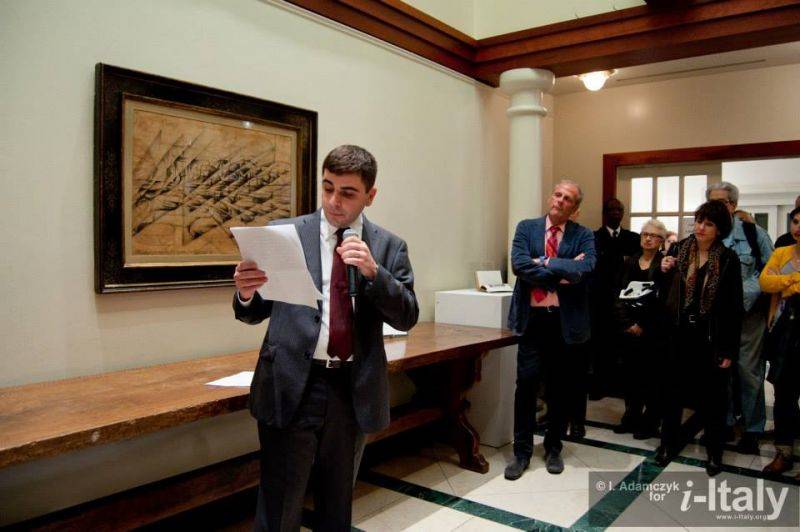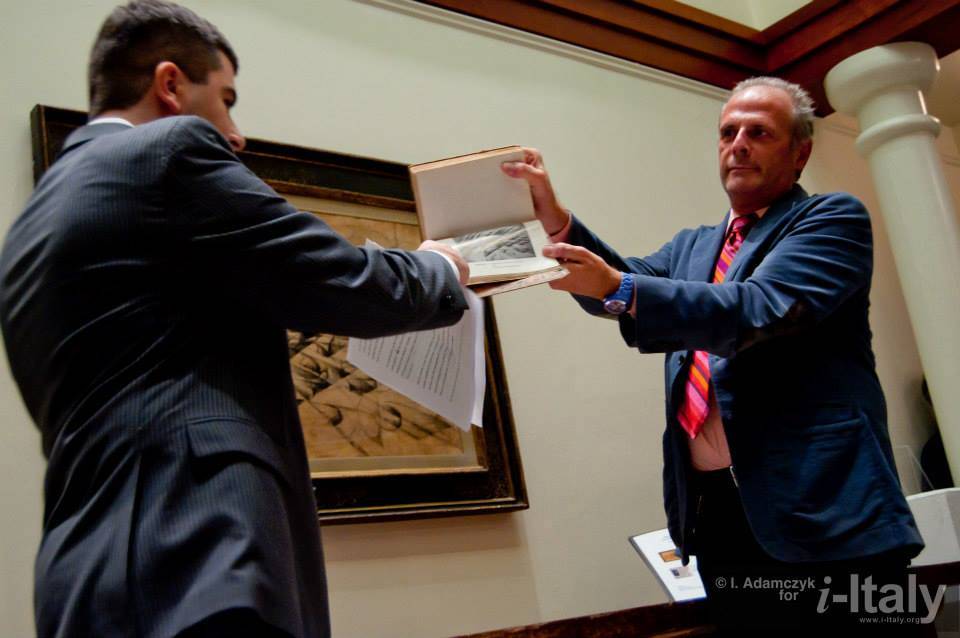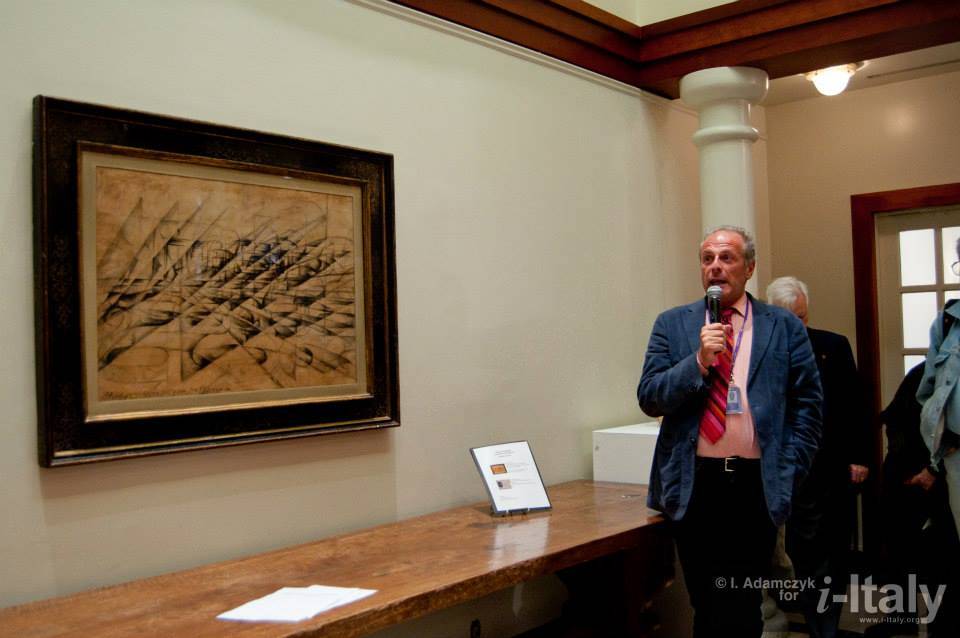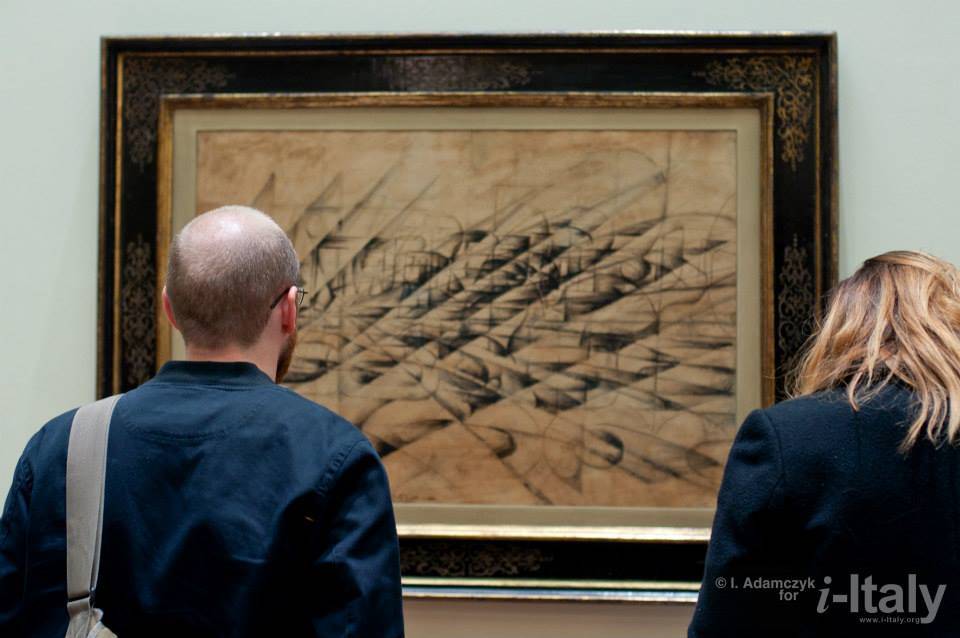Giacomo Balla's "Penetrazioni dinamiche d'automobile" @ NYU
Last on view in the United States during the 1915 Panama-Pacific International Exposition in San Francisco, Giacomo Balla's Penetrazioni dinamiche d'automobile (1912-13), the iconic work of art plays a fundamental role in Balla's dynamic contribution to Futurist aesthetics, was presented, for a day only, at Casa Italiana Zerilli Marimo (NYU). The piece will be up for grabs on November 5 at Christie's.
“We are in front of a painting that celebrates speed and the last time a group of people like us stood in front of it was 98 years ago,” Nicola Lucchi doctoral student in the Italian department at NYU said at the presentation, “Our predecessors were looking at this Balla at the Panama-Pacific International Exposition in San Francisco: when searching for contemporary Italian art, the expo's visitors were directed two different ways - the official Italian pavilion which was filled with very academic paintings that were typically Italian as per their artificiality.
The second possibility was to walk further to a gallery annex and experience what unofficial Italy had to offer. That was the first exhibition of futuristic art in the United States.”
Balla's drawing was in a position of regard, either the first or last to see in the room.
“Tonight we have the privilege of re engaging in a dialogue interrupted almost a century ago,” Lucchi continued, “This is an important Balla, its dimensions alone prove that the painter considered it more than just a simple study.
Its value was also recognized by Umberto Boccioni, at the time the was most influential amongst futuristic painters, and he reproduced it in this fundamental book “Pittura e Scultura Futuriste” also here tonight thanks to Christie's.”
Art scholars and enthusiasts were left speechless by the stunning and complex artwork also reproduced in the small book, but with a difference: a dedication.
“The painting represents one of the first compositions in which Balla explored the theme of velocità meccanica, which signifies the second stage in his study of the pictorial exploration of movement (the first being dedicated to movimento organico),” Paolo Baldacci and Flavio Fergonzi wrote in a critical and historic essay reproduced by Christie's, “Disgregazione x velocità, Penetrazioni dinamiche d'automobile, which is among the most representative and recorded on the subject, was untraceable for over seventy years, and has recently re-emerged in an American collection, whose owner purchased it in Italy in the 1950s. The work was originally undated and was only signed 'BALLA' (lower left), as shown in the image published by Umberto Boccioni in 1914.
At an unspecified date, probably towards the end of the 1930s, Balla likely gifted Disgregazione x velocità, Penetrazioni dinamiche d'automobile to a friend named Pelliccia, then adding, in a new medium, an additional inscription to the signature 'BALLA: FUTURISTA 1912 PER PELLICCIA.' It has been, and still is, quite hard to identify Pelliccia. The most reasonable argument allows us to believe it could be the well-known violinist Arrigo Pelliccia (Viareggio 1912-Rome 1987). In fact, Balla himself used to be an amateur violin player, and one of his most important paintings is La mano del violinista (The Hand of the Violinist), 1912 (London, Estorick Collection); it seems therefore likely that Arrigo Pelliccia, who was already famous at the end of the 1930s, met with Balla and was given the present work from him as a tribute.”
“The fact that this is a drawing does not detract from its importance on the contrary Balla's refusal to engage with paint embellishments, with the exception of some functional chiaro scuro, demonstrates his desire to abandon an impressionistic and the figurative style in favor of a more conceptual one,” Lucchi concluded, “But what does this art work tell us? Why are we here looking at it instead of leaving it behind in a storage unit? This drawing is a testament to an era.”
Balla and the Futurists aimed at depicting movement, which they saw as symbolic of their commitment to the dynamic forward thrust of the twentieth century. “Through Futurism Balla celebrated the machine and his early futurist paintings were concerned with capturing figures and objects in motion.”
Looking at Penetrazioni dinamiche d'automobile we can see an autombile and a driver, we see wheels deformed by speed and clouds of dust. Indeed the drawing portrays a car in motion, it captures movement, sound and light in their shifting dynamisms. The result is a vortex of lines, acute angles and spirals. It is quite abstract in its effect yet it represents the strong impetus and unique innovations of Balla's art which determined the Futuristic movement's influence on art .








































i-Italy
Facebook
Google+
This work may not be reproduced, in whole or in part, without prior written permission.
Questo lavoro non può essere riprodotto, in tutto o in parte, senza permesso scritto.